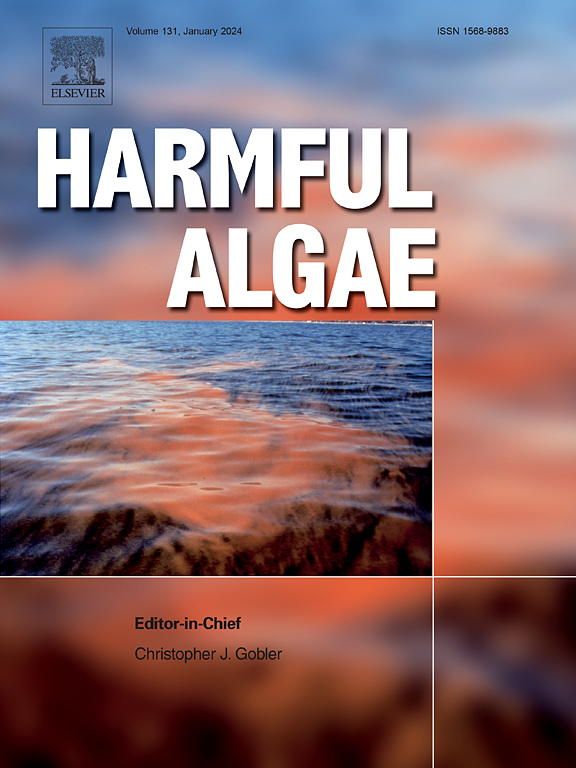Context-dependent allelopathy in algal interactions: Insights from laboratory and natural phytoplankton communities
IF 4.5
1区 生物学
Q1 MARINE & FRESHWATER BIOLOGY
引用次数: 0
Abstract
A key aspect of algal biology is the production of chemicals used for communication and regulation of interactions. Allelopathic chemicals can facilitate competition between algae, influence community composition and drive succession in the phytoplankton. Much is still unknown about the identities of these allelochemicals, and even the ecological relevance of laboratory derived results is often unclear. We sought to evaluate the variability of allelopathy employing a systematic approach. We used Prymnesium parvum as a model to assess species-specificity of allelopathic interactions in laboratory co-cultivations. We assessed the influence of media, ratio of cell densities of the interaction partners and evaluation methods (monitoring of chlorophyll a versus cell density) on the outcome of co-cultivation experiments. Five tested ecologically relevant phytoplankton species, Dunaliella tertiolecta, Emiliania (presently Gephyrocapsa) huxleyi, Florenciella parvula, Ochromonas triangulata, and Pavlova gyrans, exhibited and experienced varying positive and negative allelopathic effects in interactions with P. parvum. Further, we document pronounced effects of variations of laboratory parameters. Among the ten possible bidirectional allelopathic relationships, half of the allelopathic effects were changed by one or more of the variable parameters tested. Allelopathy is thus not only a species-specific trait but additionally depends on the external factors present during the interactions. We support our findings through the identification of interaction patterns from mining the Tara Oceans database for reoccurring trends in natural and laboratory communities. This study strongly supports the notion that allelopathic activity of an alga is not only a species-specific property but also depends on many external parameters that have to be considered and thoroughly documented in future studies of allelopathy.

藻类相互作用中的环境依赖化感作用:来自实验室和天然浮游植物群落的见解
藻类生物学的一个关键方面是用于交流和调节相互作用的化学物质的产生。化感化学物质可以促进藻类之间的竞争,影响群落组成和驱动浮游植物的演替。这些化感物质的特性仍有许多未知之处,甚至实验室得出的结果的生态相关性也常常不清楚。我们试图用系统的方法来评估化感作用的变异性。我们使用小樱草作为模型来评估化感作用在实验室共培养中的物种特异性。我们评估了培养基、相互作用伙伴的细胞密度比和评估方法(监测叶绿素a与细胞密度)对共培养实验结果的影响。五种与生态相关的浮游植物,Dunaliella terolecta, Emiliania(目前的Gephyrocapsa) huxleyi, florrenciella parvula, Ochromonas triangulata和Pavlova gyrans,在与parvum的相互作用中表现出不同的正性和负性化感作用。此外,我们记录了实验室参数变化的显著影响。在10种可能的双向化感作用关系中,一半的化感作用被一个或多个变量参数所改变。化感作用不仅是一种物种特有的性状,而且还取决于相互作用过程中存在的外部因素。我们通过挖掘塔拉海洋数据库以确定自然和实验室群落中重复出现的趋势的相互作用模式来支持我们的发现。本研究有力地支持了这样一种观点,即藻类的化感作用不仅是一种物种特异性的特性,而且还取决于许多外部参数,这些参数必须在未来的化感作用研究中加以考虑和充分记录。
本文章由计算机程序翻译,如有差异,请以英文原文为准。
求助全文
约1分钟内获得全文
求助全文
来源期刊

Harmful Algae
生物-海洋与淡水生物学
CiteScore
12.50
自引率
15.20%
发文量
122
审稿时长
7.5 months
期刊介绍:
This journal provides a forum to promote knowledge of harmful microalgae and macroalgae, including cyanobacteria, as well as monitoring, management and control of these organisms.
 求助内容:
求助内容: 应助结果提醒方式:
应助结果提醒方式:


